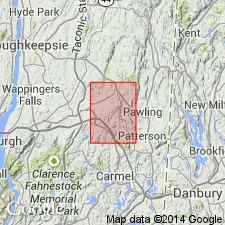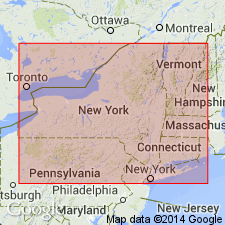
- Usage in publication:
-
- Wappinger Group*
- Modifications:
-
- Revised
- AAPG geologic province:
-
- New England province
Summary:
The Wappinger Formation is here adopted and raised to group rank. It includes the Stissing Formation of Early and Middle(?) Cambrian age, the Pine Plains Formation of Middle(?) and Late Cambrian age, the Briarcliff Dolomite of Late Cambrian age, the Halcyon Lake Formation of Early Ordovician age, and the Rochdale Limestone of Early Ordovician age.
Source: GNU records (USGS DDS-6; Reston GNULEX).

- Usage in publication:
-
- Wappinger Group
- Modifications:
-
- Revised
- AAPG geologic province:
-
- Appalachian basin
Summary:
Author uses the term Wappinger as a group name within the Sauk Sequence following the recommendation of Fisher (1977). The Wappinger is subdivided into the basal Poughquag Quartzite, Stissing Dolomite, Pine Plains Formation, Briarcliff Formation, Halcyon Lake Formation, Rochdale Limestone, and Copake Limestone.
Source: GNU records (USGS DDS-6; Reston GNULEX).
For more information, please contact Nancy Stamm, Geologic Names Committee Secretary.
Asterisk (*) indicates published by U.S. Geological Survey authors.
"No current usage" (†) implies that a name has been abandoned or has fallen into disuse. Former usage and, if known, replacement name given in parentheses ( ).
Slash (/) indicates name conflicts with nomenclatural guidelines (CSN, 1933; ACSN, 1961, 1970; NACSN, 1983, 2005, 2021). May be explained within brackets ([ ]).

